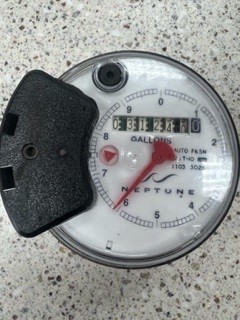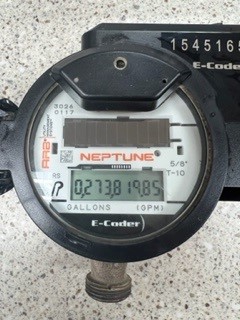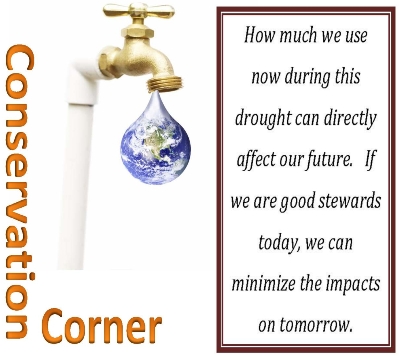INSTRUCTIONS FOR HOW TO CHECK FOR A LEAK AT YOUR METER
**In the event of high usage or concerns that you may have a leak, please review the following information. The District does not service any lines past the meter, from the meter to the house, barns, etc. are the landowner’s responsibility.
First you will need to locate your meter pit. These are typically located at the end of a drive or near the road. There will be a round metal lid marked “water meter” and you need to open the lid to access the meter. (Sometimes using the back of a claw hammer may help). The meter is located inside the pit. If you see wires attached, please gently lay the lid to the side taking care not to disconnect the wires. There is no electricity attached to the wires, and it is still safe to access the meter pit.
If there is water inside the pit, you will need to use something to scoop out the water or by using a pump if you have one available. Some meter pits may regularly hold water. It may also be from run off due to weather conditions, or could be from a potential leak.
Next you will need to determine what type of meter you have.
Regular Meters:

INSTRUCTIONS:
First make sure there is no water running inside or outside.
- Next check the meter. Please do not turn off the meter when checking for a leak. If the meter is off it will prevent any water from passing through your service line and will affect your results. (You may need to take something to wipe off the meter face. It is not uncommon for the meters to build up a dirty film which can give the appearance of a cap/lid).
- Make sure the red triangle Δ is not spinning. If the triangle is spinning (and you are not aware of any water being used) there is water passing through the meter and may be indicating a leak or something is running.
- If the meter is not spinning, take a reading. It will read like a car odometer. There will be seven digits; the last digit is a non-moving zero. (Please write down your readings, this will help if you need any assistance from the District Office.)
- Do not use any water for at least thirty minutes, if possible, wait one hour.
- Then after that time, take another reading to see if it has changed. If it has, there is water passing through the meter and you may have a leak.
E-Coder Meter Sets:

INSTRUCTIONS:
First make sure there is no water running inside or outside.
Most Ecoders will have a black lid on a hinge on the meter. You will need to lift open the lid to see the meter face. You will see a solar panel and digital reading box. Sometimes the numbers may not be visible because the meter is “sleeping.” If that happens, you can wake up the meter by shining a bright flashlight onto the solar panel (similar to the picture above). It may take 15-30 seconds for the reading to appear. (If the meter begins to flash the code”low light” you will need a brighter light source.)
Once the meter is awake, the numbers will become visible.
Next take a reading, wait 30-60 minutes without using water, and then take another reading. If the reading changes, water is being used. You can also check the Flow Rate on the meter to see if it is indicating use at any time.
***See chart below for additional information regarding the symbols on the meter:
***If you find that you have a leak, the water can be turned on and off at the meter when not in use to help minimize the water loss until you can get the leak repaired. You can repeat the previous steps to narrow down possible locations for a leak by using shut off valves (if available), such as a shut off to the house or any outside hydrants.
During extremely cold temperatures, make sure the meter pit lid is securely closed when not in use to prevent the meter from freezing.
FAQS:
What do I do if I have a high bill?
The District billing runs a month behind. When you receive your bill verify the usage dates on the top right section of the statement to help determine if you were using additional water at that time. During summer months higher usage may be caused by: pools, watering (gardens, flowers, trees, grass), hoses that have been left running, extra watering for animals, sprinkler systems, etc. During winter months it could be: faucets left dripping for cold weather, extra watering of animals due to frozen water conditions, or furnace humidifiers. If you still cannot account for the usage, begin checking for a leak.
What are common places for leaks to occur?
Common culprits for leaks are toilets, sinks, anywhere you have a connection in the water line, livestock waterers or water hoses left on.
Will I see a leak if I have one?
You will NOT always see water above ground if you have a leak, especially if you live in a rocky area.
Who do I contact if I have a leak?
If you determine you have a leak, you would need to take steps to repair it or contact someone who would be able to. The District cannot make any recommendations on who to hire.
Will I hear my toilet run if its the problem?
Toilets do not always create a full running sound, it may be seeping water. We usually recommend adding Koolaid or food coloring in the tank of the toilet. Then do not flush the toilet for a significant amount of time (for example overnight, or during the day) and see if the color has gone into the toilet bowl. If it does, the toilet may be seeping water. Fixing that leaky toilet can save as much as 500 gallons per day.
My pressure is low, what do I do?
If you suddenly have low pressure, check your meter to see if a leak has occurred. Water softeners can also cause low pressure if they are having an issue. If we are experiencing any leaks or if work is being done, information is available online at our website, Facebook, and Twitter pages . If you do not see anything relating to you, call the office.
Why are the readings on my bill different than the usage?
Our billing system does not print the final zero that would show on your meter. We have two styles of meters used in the District. Some contain more numbers, including a decimal, other meters contain a stationary zero at the end. You will need to add the ending zero to the readings to calculate your usage.
Does my meter get read every month?
The District subcontracts two meter readers that read the meters each month. Both meter readers are required to read every meter in their routes. Occasionally, reading time lengths may vary due to weather or illness.

Conservation Tips
Inside the Home
-
- Keep a pitcher of water in the refrigerator rather than running the tap until the water gets cold.
- Replace five-gallon-per-flush toilets with standard 1.9 gallon-per-flush models. This can save an average of 18,600 gallons of water per year and about $75
- Repair dripping faucets by replacing washers. One drop per second can add up to 2,700 gallons per year.
- Don’t let the water run while brushing teeth, shampooing your hair or shaving. On average, you will save more than four gallons of water.
- Take shorter showers. Install low flow shower heads. A quick shower rather than a bath can save an average of 20 gallons of water. EPA recommends taking three to five minute showers.
- When running a bath, plug the tub before turning the water on, and then adjust the temperature as the tub fills up.
- Keep a bucket in the shower to catch water as it warms up or runs. Use this water to water plants.
- Use both sides of the sink when washing dishes: one side to wash and the other to rinse. Don’t wash the dishes with the water running.
- Soak pots and pans instead of letting the water run while you scrape them clean.
- Wash your fruits and vegetables in a pan of water instead of running water from the tap.
- Collect the water you use from rinsing fruits and vegetables, and then reuse it to water household plants.
- Garbage disposals use approximately 11.5 gallons of water per day. Try composting organic wastes instead.
- Install flow restrictors in faucets.
- When cleaning a fish tank, use the drained water on plants. The water is rich in nitrogen and phosphorus, a healthy treat for plants.
- Never pour water down the drain when there may be another use for it such as watering a plant or cleaning around your home.
- Monitor your water bill for unusually high use. Your bill and water meter are tools that can help you discover leaks.
Outside
-
- Use mulch around trees to slow evaporation.
- Install covers on pools and spas and check for leaks around pumps.
- Water lawns and plants early in the morning or during the evening when there’s less evaporation.
- Water your lawn only when it needs it and adjust sprinklers so you’re not watering the sidewalk or street. Also, aerated lawns absorb water better. Direct downspouts and other runoff toward shrubs, trees and gardens.
- Implement an alternate day (odd/even) schedule for outdoor watering. (i.e. residents with even numbered addresses water on even numbered days, those with odd numbered addresses water on odd numbered days)
- Use sprinklers that deliver big drops close to the ground. Smaller water drops and mist often evaporate before they hit the ground.
- Use soaker hoses to water plants more efficiently.
- Set a kitchen timer when watering your lawn or garden to remind you when to stop. A running hose can discharge up to 10 gallons or more a minute.
- Use drip irrigation for shrubs and trees to apply water directly to the roots where it is needed.
- Plant drought-resistant trees and plants.
- When you give your pet fresh water, don’t throw the old water down the drain. Use it to water your trees or shrubs.
- Use a broom instead of a hose to clean sidewalks and driveways.
- Use a commercial car wash that recycles water.
- Encourage your school system and local government to develop and promote a water conservation program among children and adults. By following these simple suggestions, homeowners can conserve hundreds of gallons of water, saving money for themselves and their communities, helping water supplies withstand drought and lowering energy costs.
